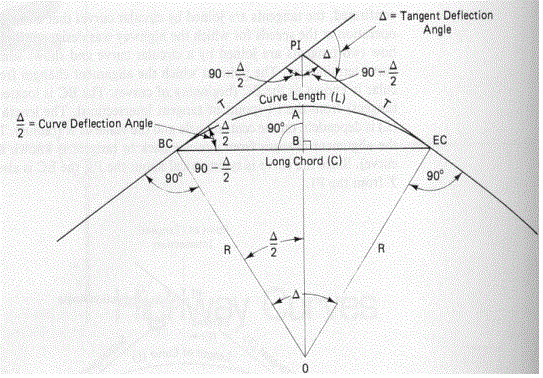larcix
Structural
- Feb 18, 2022
- 27
I'm working on studying for my PE, but one of my practice exam questions is confusing me, even with the answer worked in the back. I think they forgot to multiple by 2, which is pretty bad for a reference practice exam. Maybe you can direct me to my mistake:
Here is the question (its only a text question):
For a new horizontal curve with the following givens:
Station at PI = 12+40.00
Degree of curve = 10°
Deflection angle = 12°30'
Question: What's the station at PT?
I understand that the station is just 1240', and the Degree of Curvature, D, is the degree the curve sweeps over a chord/arc length of 100'. I also found online (and was able to convince myself this was correct) that the Deflection Angle is equal to the intersection angle divided by 2, the intersection angle being the total angle the curve must sweep from PC to PT, so the answer is basically just:
Length of curve = [Total sweep angle]/[sweep angle per 100'] = 2*[Deflection Angle]/[degree of curve] * 100' = (2*12.5/10)*100' = 250'
Station PC = PI - L/2 = 1240 - 250/2 = 1115
Station PT = PC + L = 1115 + 250 = 1365'
The final answer is 13+65.00
The available options are 12+80, 13+2, or 13+65. The answer in the back doesn't multiple the Delfection Angle by 2, gets a curve lenght of 125' and the station at 13+2. Based on everything I can find, that's wrong.
Here is the question (its only a text question):
For a new horizontal curve with the following givens:
Station at PI = 12+40.00
Degree of curve = 10°
Deflection angle = 12°30'
Question: What's the station at PT?
I understand that the station is just 1240', and the Degree of Curvature, D, is the degree the curve sweeps over a chord/arc length of 100'. I also found online (and was able to convince myself this was correct) that the Deflection Angle is equal to the intersection angle divided by 2, the intersection angle being the total angle the curve must sweep from PC to PT, so the answer is basically just:
Length of curve = [Total sweep angle]/[sweep angle per 100'] = 2*[Deflection Angle]/[degree of curve] * 100' = (2*12.5/10)*100' = 250'
Station PC = PI - L/2 = 1240 - 250/2 = 1115
Station PT = PC + L = 1115 + 250 = 1365'
The final answer is 13+65.00
The available options are 12+80, 13+2, or 13+65. The answer in the back doesn't multiple the Delfection Angle by 2, gets a curve lenght of 125' and the station at 13+2. Based on everything I can find, that's wrong.

